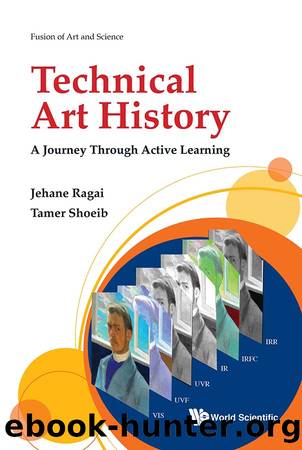Technical Art History by Jehane Ragai

Author:Jehane Ragai
Language: eng
Format: epub
Publisher: World Scientific Publishing Company
Published: 2021-01-15T00:00:00+00:00
Questions
Revision questions:
1. What led to the conclusion that the painting was a copy of Poussinâs The Flight into Egypt? What indications do we have that the copyist was closely familiar with Poussinâs techniques?
2. Give three stylistic characteristics of Nicolas Poussin.
3. How does Poussin give the illusion of relief and space?
4. Were the scientific investigations carried out on this painting using totally non-invasive techniques? Elaborate.
5. What does the use of raking light reveal in a painting?
6. What did the cross-section analysis of the painting reveal? Why is cross-section analysis also needed to confirm or disprove the existence of a retouch?
7. Why did Poussin generally do underdrawings?
8. What is the difference of approach in the infrared transmission (IRT) imaging and the infrared reflectography (IRR) imaging techniques?
9. Why does IRT give us useful additional information as compared to IRR?
10. In Fig. 8.2E (Endnotes page 154), what additional information did the IRT give us that is not visible in the IRR image?
11. What is the principle of proton-induced X-ray emission (PIXE) and what are the advantages of such a method over the conventional X-ray fluorescence (XRF) technique?
12. What is the chemical name for verdigris? Why does it, with the passage of time, acquire a brown in a painting?
13. Why is verdigris considered in this case to be an anachronistic pigment even though it was extensively used in the 17th century?
14. What is the best kind of lamp to be used with IRT? Explain.
15. By what technique was PIXE complemented in the present case?
16. Why is this a particularly challenging case of authentication?
Exploratory questions:
1. It is not uncommon for art historians and curators to come to the conviction that pictures long thought to be by Old Masters were in fact the creations of one of the Masterâs advanced pupils. The Adoration of the Shepherds, which since the early 19th century was thought to be by Rembrandt and donated to the National Gallery in London by John Julius Angerstein, Lloydâs chairman between 1790 and 1796 and financial advisor to Prime Minister Pitt, is one such example. Research this picture and detail why it is the current thought of the National Gallery curators that a pupil of Rembrandt executed it.
2. What is the difference between a twill and a tabby weave? Depict such a difference with relevant sketches.
3. What inconveniences or disadvantages does the PIXE technique have?
4. What is the composition of ultramarine?
5. What pigments do you suggest were used by Poussin to get the red and grey underlayers?
6. Find out on the internet if any of todayâs famous forgers had forged a Poussin painting.
7. The Prado Mona Lisa (1480â1524), a painting of the same subject as Leonardo da Vinciâs Masterpiece Mona Lisa (1503â1506) held at the Louvre, has been in the permanent collection of the Museo del Prado in Madrid, Spain since 1819, cataloged as an anonymous copy of the Mona Lisa from the first quarter of the 16th century. After a 2012 restoration of the Prado Mona Lisa, in which the picture was scientifically analyzed, the attribution was changed.
Download
This site does not store any files on its server. We only index and link to content provided by other sites. Please contact the content providers to delete copyright contents if any and email us, we'll remove relevant links or contents immediately.
Technical Art History by Jehane Ragai(229)
The Slavic Myths by Noah Charney(187)
Drawing Landscapes by Barrington Barber(172)
Simply Artificial Intelligence by Dorling Kindersley(164)
Drawing for the Soul by Zoë Ingram(157)
The Art of Painting Sea Life in Watercolor by Maury Aaseng Hailey E. Herrera Louise De Masi and Ronald Pratt(150)
Compacts and Cosmetics by Madeleine Marsh(145)
The Art of Portrait Drawing by Cuong i(145)
Preparing Dinosaurs by Wylie Caitlin Donahue;(138)
Egyptian art by Jean Capart(133)
A text-book of the history of painting by Van Dyke John Charles 1856-1932(127)
Winslow Homer by Shibutani Baku(123)
Through Japan with Brush & Ink by Chiura Obata(108)
Pornoterrorism: De-Aestheticising Power by Louis Armand Jaromir Lelek(103)
Botanical Illustration by Valerie Price(102)
Culture and Ideology under the Seleukids by Eva Anagnostou-Laoutides Stefan Pfeiffer(102)
Jane Evans. Chinese Brush Painting. A Complete Course in Traditional and Modern Techniques by Unknown(94)
The Dali Legacy by Christopher Heath Brown(92)
Medieval and Renaissance Fashion by Raphaël Jacquemin(91)
